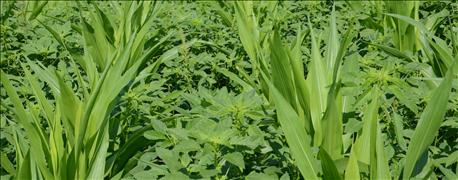
Is crop scouting a luxury or a necessity? Or should you figure out some other way to make sure your fields are scouted?
Three industry people were asked for concrete examples showing crop scouting pays. All are Indiana Certified Crop Advisers. Jesse Grogan is an agronomist with LG Seeds, based in Lafayette. Tom Stein is branch manager for Ceres Solutions at the Boswell/Templeton branches. Greg Knuebuhler, Harlan, owns his own crop consulting firm, G & K Concepts. Here are their examples.
1. You get another set of eyes to look for problems while you’re still planting and spraying.

TOO LATE! This Palmer amaranth infestation is out of control. If scouting found the escapes shortly after they emerged, a rescue treatment might have helped.
“A farmer is focused on preparing and planting acres on a timely basis,” Grogan says. “He has little time to go back and review what has been planted, and to evaluate stands and crop conditions. A crop scout goes out at emergence and can identify a problem that needs immediate attention.”
Related: Your smartphone may be your crop scouting tool
Suppose you replant 200 acres of corn on a timely basis because the crop scout identified a problem. If that makes a yield difference of 20 bushels per acre, you gained $70 more revenue per acre at $3.50 per bushel corn. That’s $14,000 more total income. Even if you pay $5 per acre for 1,500 acres scouted and that’s the only benefit from scouting that you get, you’re $6,500 ahead.
2. Someone devoted totally to scouting could catch weed problems early enough to control them.
“A good Integrated Pest Management Program is a low-risk, high reward proposition,” Stein says. For example, suppose you have a corn field with some giant ragweed problems that you weren’t aware of. One giant ragweed per square yard reduces yield about 13%, Stein says.
If you had potential for a 220 bushel per acre corn crop and corn was $3.50 per bushel, you’re looking at a potential loss of $100 per acre based on the amount of giant ragweed present in this example. If your field scout identified the problem in a timely fashion, and if the cost of a herbicide application was $25 per acre, you stand to gain $75 per acre. “I would say that’s pretty good use of your working capital,” Stein concludes.
3. Scouting needs vary by operation, and have different benefits depending upon your goals.
“Some operations have the power to scout on their own, and some prefer a second set of eyes,” Knuebuhler says. “I have no problem if each operation is willing to scout their own crops, as long as they actually do it.”
Related: 3 resources for more effective crop scouting
The one thing to guard against if you do your own scouting is not getting it done in a timely fashion, he adds.
Suppose you know you need to scout for head scab in wheat, but get tied up with other tasks. “If timing is off on that one and you miss the time to apply fungicide, it can cost you 20 bushels per acre in high-management wheat programs. That one decision could pay for scouting for a whole year.”
About the Author(s)
You May Also Like




